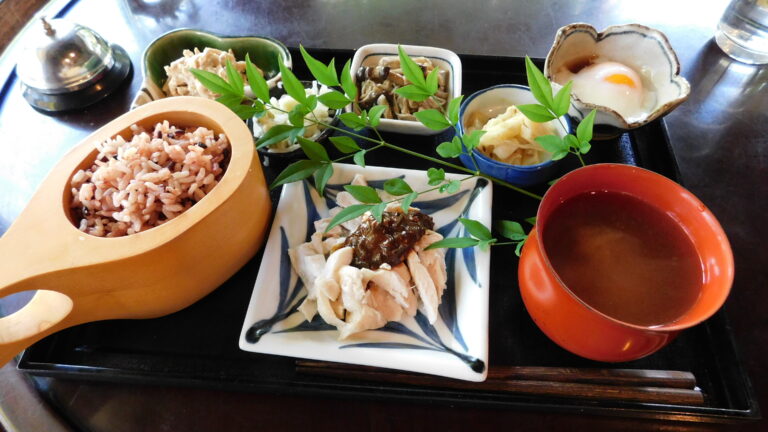After climbing a gentle slope in Midori-ku, you’ll find “Nagomi (753) Village,” with a Japanese-style house, shop, and gallery. Occasional markets and other events take place here, attracting local residents in the Nakayama area. The main attraction is “Qin Café 753,” inside a refurbished old folk house. Looming over the roof is a huge cherry tree, nearly one hundred years old. Kazuki Tsuji, the owner of the cafe, has two decades of experience in French cuisine.
According to Tsuji, during his training in France, he reconsidered the charms of Japanese food culture, especially the traditional seasoning, shōyu (soy sauce). Upon returning to his homeland, he learned about its brewing process. He became obsessed with the depth of the process of fermentation, which had evolved to match Japan’s terroir. All the fermented seasonings that he now uses, such as shōyu, miso (fermented soybean paste), and kōji (yeast used in producing sake), are homemade and aged for a long time. When he buys organic vegetables, he values his long connections with farmers who are passionate about growing them. He specifically chooses them when they are in season, so they are high in nutrition. Tsuji’s original goal was to grow his own vegetables, which led him to open the café.
The regular menu consists of two options: a plate with one soup and three dishes (¥828) or one soup and five dishes (¥1139). After you make your choice, you’ll select meat or fish (¥369) from the set menu. I recommend ordering one of their fermented drinks, including seasonal amazake (sweet non-alcoholic sake) or spiced lemonade carbonated and fermented as an aperitif. Their dessert menu includes chiffon cake made with rice flour with a choice of four different flavors, such as homemade miso, shōyu, lemon, and basil of the day. In addition to that, they also have soy milk and amazake soft serve ice cream with a hint of homemade enzyme syrup (kin cream ¥369 and kin parfait ¥1506) as well as seasonal vegan cake (¥700~). Items are available for takeout too.
Look out the window and imagine how beautiful the garden will be when the old sakura tree is in full bloom. In autumn, maple leaves will turn red, which will surely catch your eye. It is easy to relax in the old Japanese house, even in summer, since it is constructed of breathable natural materials and surrounded by lots of trees. In winter, charcoal burned in the irori (Japanese fireplace) will keep the room warm. This place lets you appreciate the beauty of nature in a “retro” atmosphere reminiscent of the early 20th century. Take your time and enjoy eating elaborate dishes of Japanese traditional fermented food.


